What Guitar Does Trey Anastasio Play, you ask? At guitarplayers.net, we’re diving deep into the world of Trey’s iconic sound, exploring the instruments that define his unique style and tone, helping guitar enthusiasts and Phish fans alike discover the magic behind his music. Join us as we unravel the secrets of Trey’s guitars, his signature sound, and how you can capture a piece of that magic for yourself through tone exploration, gear insights, and musical inspiration!
1. What Kind of Guitars Does Trey Anastasio Primarily Play?
Trey Anastasio is primarily known for playing custom-made guitars by Paul Languedoc. These guitars are celebrated for their unique combination of features from both Fender and Gibson guitars, offering a versatile and distinctive sound. Languedoc guitars have a 25.5″ neck scale, similar to a Fender Stratocaster or Telecaster, but are equipped with dual humbucker pickups like a Gibson Les Paul, 335, or SG. This combination gives them a bright, articulate tone with plenty of power and sustain.
1.1 What Makes Languedoc Guitars Special?
Languedoc guitars stand out due to their unique construction and design. Unlike mass-produced guitars that often emulate Fender or Gibson designs, Languedocs combine features from both worlds. According to Paul Languedoc Guitars, this results in an instrument that offers both a twangy, Fender-like bite and the high-output, mid-range-heavy sound of a Gibson. The hollow chamber and superior tonewoods further enhance the guitar’s natural tone and sustain.
1.2 How Do These Guitars Contribute to Anastasio’s Sound?
These guitars provide Anastasio with a wide range of tonal possibilities, allowing him to move seamlessly between clean, shimmering chords and powerful, overdriven leads. The unique combination of scale length and pickups gives his sound a distinctive character that is instantly recognizable. According to Anastasio himself, his Languedoc guitars have “the bite of a Strat and … the meat of a hollowbody,” offering a perfect blend of clarity and power.
2. What Are Some of Trey Anastasio’s Most Famous Languedoc Guitars?
Trey Anastasio has owned and played several Languedoc guitars throughout his career, each with its own unique characteristics and story. Here are some of his most famous Languedoc guitars:
| Guitar Name | Year Built | Key Features |
|---|---|---|
| Old Reliable (“Mar Mar”) | 1987 | Also known as “Blonde No. 1,” this guitar was built in 1987 and has a unique headstock shape, unlike Paul’s later Vermont-inspired designs. It was famously reinstalled with a single coil for Fare Thee Well. |
| Spruce “I’m the Mar-Mar” | 1991/2014 | Originally built in 1991, this guitar was refurbished in 2014 with a sunburst refinish. It features a spruce top and maple back, and the headstock depicts Marley chasing a cat. |
| Koa 1 | 1996 | This guitar features rectangle inlays and white plastic binding, and it was heavily used during the Baker’s Dozen run at Madison Square Garden. In 2022, it was updated with a push-pull knob and TRS output. |
| Koa 2 | 2002 | Featuring a more prominent flame than Koa 1, this guitar has a bracket inlay at the 12th and 24th frets. As of 2019, it includes a TRS output for direct amp and effects rig connectivity. |
| Ocelot (Koa 3) | 2010 | This guitar has an ocelot inlaid on the headstock, a very prominent flame, and redwood binding. It also features bracket-style inlays at the 12th and 24th frets, and in 2020, it was drilled for a second output. |
2.1 Old Reliable (“Mar Mar”)
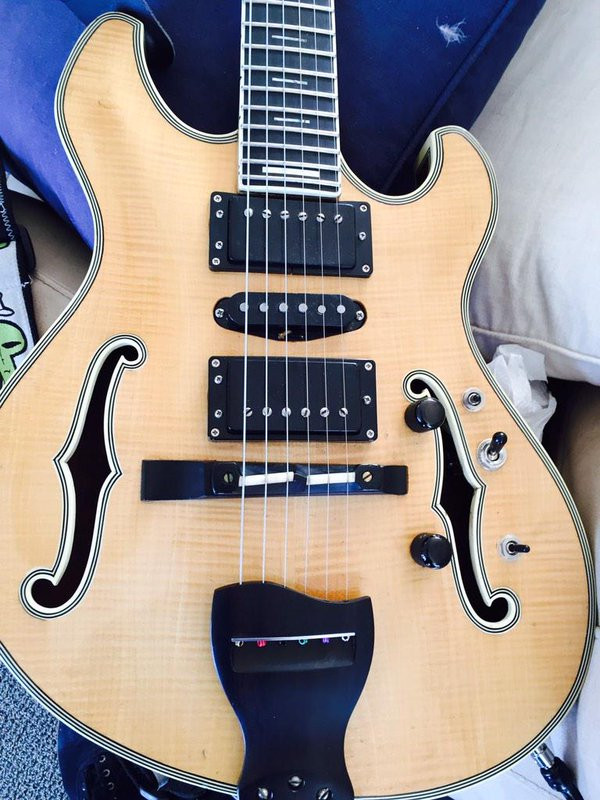 No 1 – Old Reliable
No 1 – Old Reliable
Also known as “Blonde No. 1”, this guitar was built in 1987 and is one of Trey’s oldest and most recognizable instruments. It features a unique headstock shape and has been a mainstay in his rig for many years.
2.2 Spruce “I’m the Mar-Mar” (Refurbished 2014 with sunburst refinish)
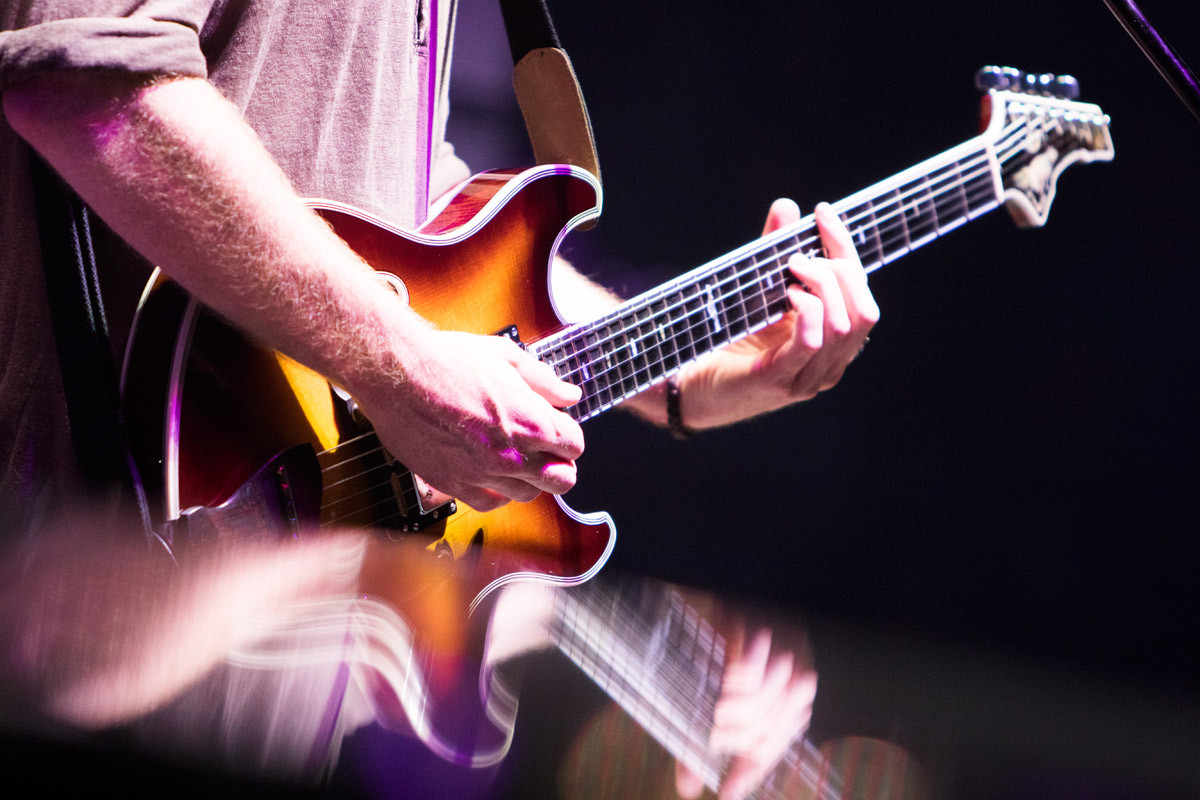 033_150102_phish_rene_huemer3Q6A0877
033_150102_phish_rene_huemer3Q6A0877
This guitar has a spruce top and maple back, and the headstock depicts Marley chasing a cat. According to Trey, the neck started to twist shortly after it was built, but Paul Languedoc refurbished it with a new neck and sunburst finish.
2.3 Koa 1 (1996)
 rack close up
rack close up
Koa 1 features rectangle inlays and white plastic binding. This guitar has been in heavy rotation in 3.0. According to treysguitarrig.com, it was used almost exclusively during the fabled Baker’s Dozen run at Madison Square Garden.
2.4 Koa 2 (2002)
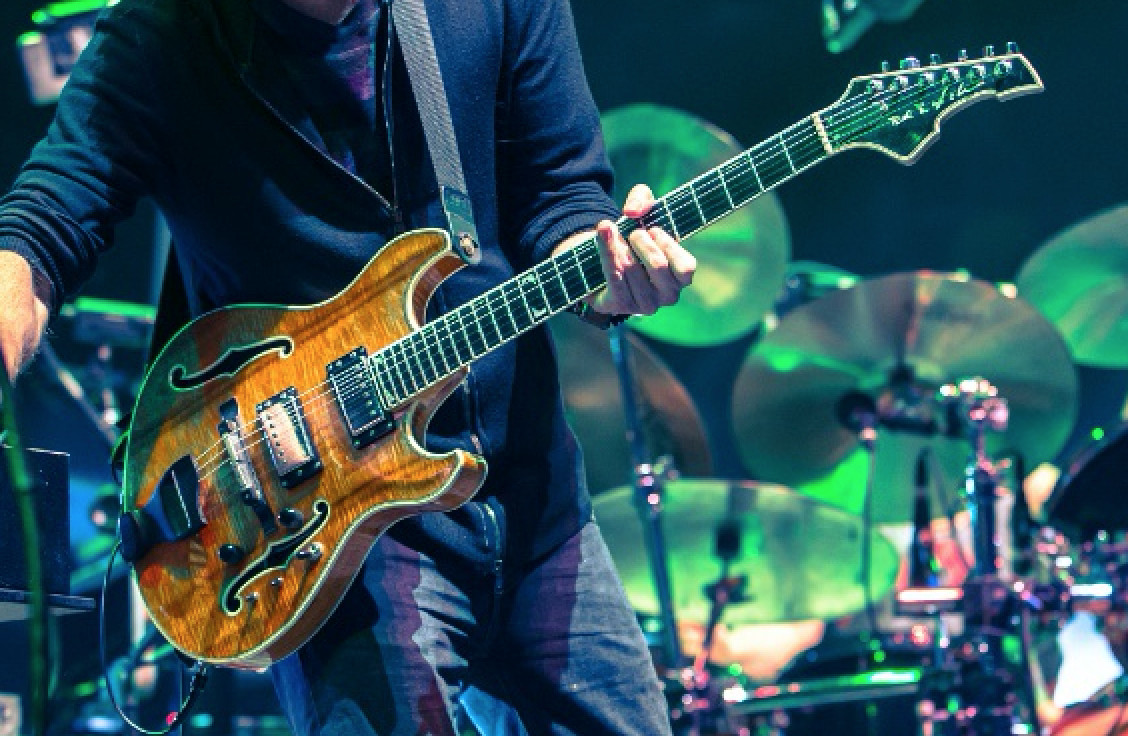 No 4 – Koa 2.png
No 4 – Koa 2.png
This guitar has a more prominent flame than Koa 1 and features a bracket inlay at the 12th and 24th frets. As of 2019, it has a TRS output for direct amp and effects rig connectivity.
2.5 Ocelot (Koa 3) (2010)
This guitar features an ocelot inlaid on the headstock, a very prominent flame, and redwood binding. According to Mr. Miner, the fan-dubbed “Ocedoc” is one of Trey’s most visually striking and sonically versatile instruments.
2.6 Blonde No. 2
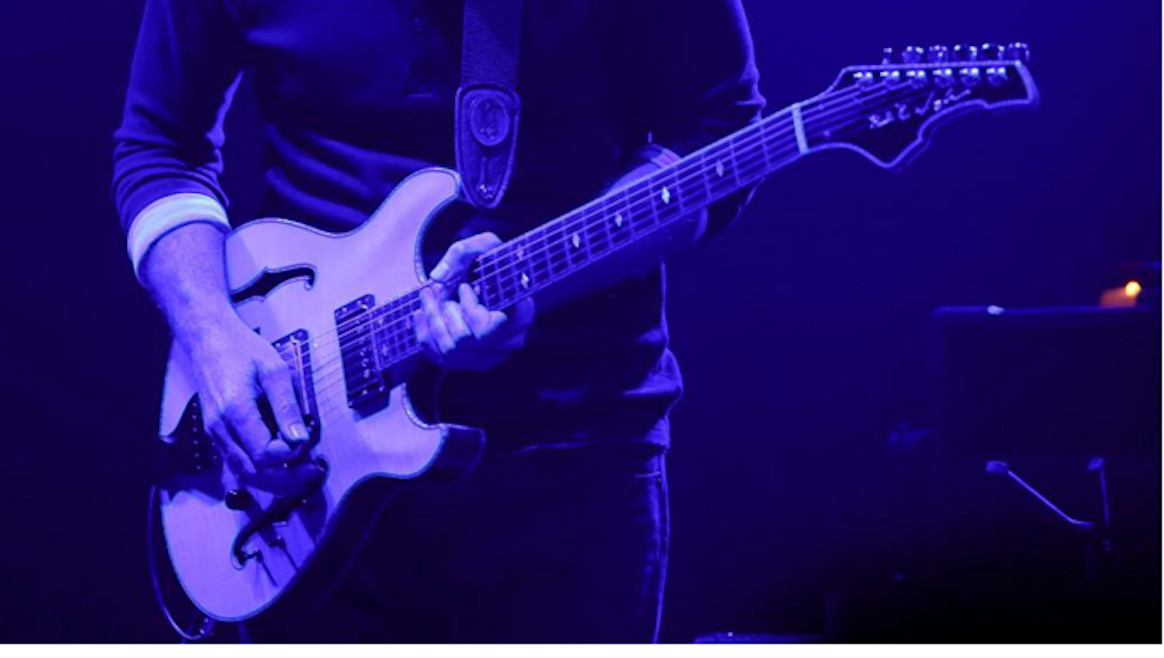 No 6 – spruce 2.png
No 6 – spruce 2.png
According to Jambase, this guitar features wood binding and Paul’s signature on the headstock. It has diamond inlays, with double-diamonds at the 12th and 24th frets.
2.7 The 4.0 Guitar (Koa 4)
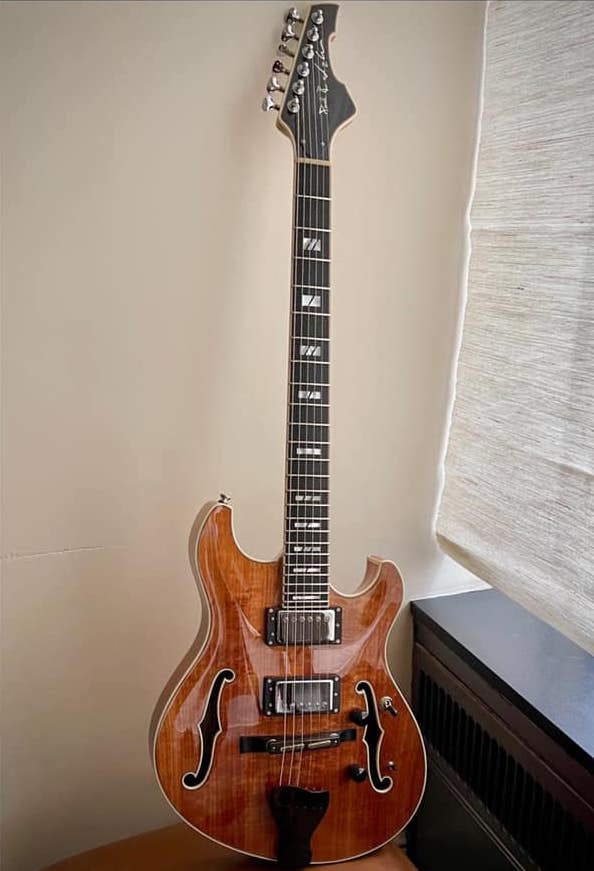
According to Anastasio’s social media, this guitar has a glistening harmonic-laden high end, a warm fundamental note, and wicked sustain.
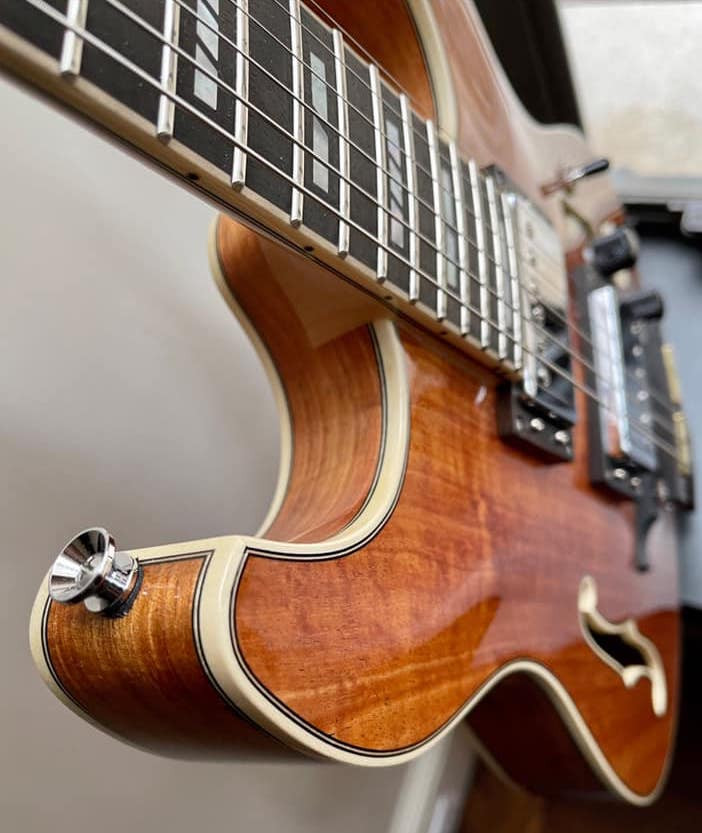
2.8 How Does Trey Choose Which Guitar to Play?
Trey’s choice of guitar often depends on the specific song, the venue, and his desired tone. He may switch guitars mid-set to achieve different sounds or to accommodate alternate tunings.
3. What Other Electric Guitars Has Trey Anastasio Used?
While Languedoc guitars are his primary instruments, Trey Anastasio has also been known to play other electric guitars throughout his career.
- Fender Stratocasters: These guitars are used for their bright, clean tones and are often seen in his rig for specific songs.
- Gibson ES-335s: These guitars offer a warm, semi-hollow sound that is well-suited for blues and jazz-influenced playing.
3.1 Why Does Trey Experiment with Different Guitars?
Trey’s experimentation with different guitars allows him to explore new sonic territories and find the perfect tone for each musical context. By using a variety of instruments, he can create a diverse and dynamic soundscape that keeps his music fresh and exciting.
4. What Acoustic Guitars Does Trey Anastasio Play?
In addition to his electric guitars, Trey Anastasio also plays a variety of acoustic guitars. These instruments are used for both live performances and studio recordings, adding a different texture and dimension to his music.
- Martin D-28: This is Martin’s flagship guitar, favored by some of the most famous players in acoustic music history. According to Gruhn Guitars, Trey seems to be favoring this almost-pre-war Martin D-28 these days.
- Martin D-35: Like the D-28, the D-35 is a dreadnought guitar. While the D-28 has a 2-piece back, the D-35 has a 3-piece.
- Martin 000-28: Trey is holding the 000-28 in the above photo, with the D-28 on the stand behind him. This guitar has been favored for alternate tunings, including open G and DADGAD, and is frequently used on fingerpicking songs.
- Martin Trey Anastasio Signature Model: This guitar features a cutaway for easy access above the 14th fret. It has rosewood sides and a 3-piece back, like a D-35, with koa in the center and rosewood on either side.
- Martin D-18 Authentic: According to Martin Guitar, this is a reproduction and not a vintage original guitar. Trey used this for the first time publicly in December 2018 on the Trey solo acoustic tour.
- Circle Strings Koa Deadnaught: This guitar was a birthday gift from Page in 2021. According to Treysguitarrig.com, there is a detailed write-up on this guitar, including a conversation with the luthier.
4.1 1943 Martin D-28 (sunburst)
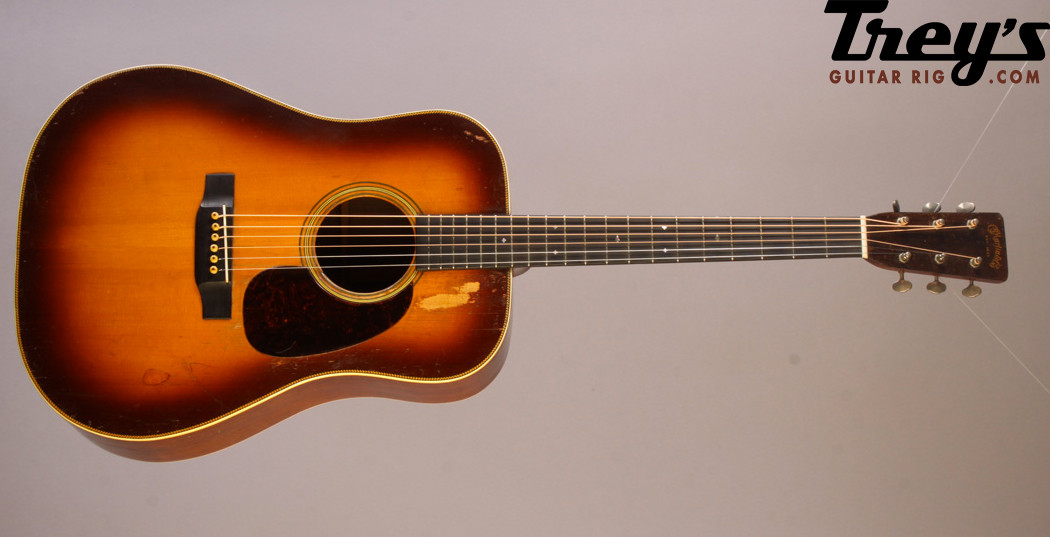 Trey D-28 – Gruhn – WM
Trey D-28 – Gruhn – WM
This guitar is favored by some of the most famous players in acoustic music history. The sunburst is original, according to an ad from Gruhn guitars that’s still up and appears to be for this guitar before Trey bought it.
4.2 1968 Martin D-35
 D-35
D-35
Like the D-28, the D-35 is a dreadnought guitar. While the D-28 has a 2-piece back, the D-35 has a 3-piece. Given the era, this guitar is likely made of Brazilian Rosewood, as well.
4.3 1933 Martin 000-28
 1933 000-28
1933 000-28
This guitar has been favored for alternate tunings, including open G and DADGAD, and is frequently used on fingerpicking songs.
4.4 Martin Trey Anastasio Signature Model
 2013 spring – NSO
2013 spring – NSO
This guitar features a cutaway for easy access above the 14th fret. It has rosewood sides and a 3-piece back, like a D-35, with koa in the center and rosewood on either side.
4.5 1939 Martin D-18 Authentic
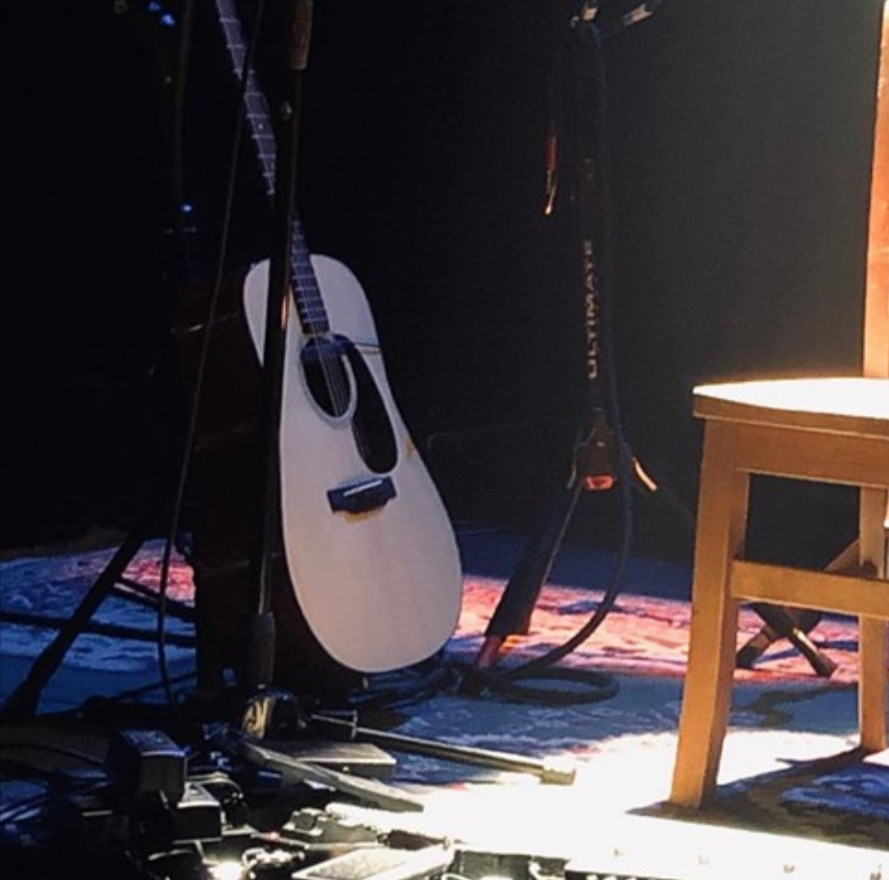 Screen Shot 2019-10-15 at 9.56.51 PM.png
Screen Shot 2019-10-15 at 9.56.51 PM.png
This is a reproduction and not a vintage original guitar. Trey used this for the first time publicly in December 2018 on the Trey solo acoustic tour.
4.6 Circle Strings Koa Deadnaught (2021)
 ©ShemRoose7R9A8125
©ShemRoose7R9A8125
This guitar was a birthday gift from Page in 2021. There is a detailed write-up on this guitar, including a conversation with the luthier.
4.7 How Do These Acoustic Guitars Fit Into His Music?
Trey’s acoustic guitars provide a warm, organic tone that contrasts with the electric bite of his Languedocs. He uses them to create intimate, introspective moments in his performances and recordings.
5. What Amplifiers Does Trey Anastasio Use?
Trey Anastasio’s amplifier setup has evolved over the years, but he is known for using high-quality amps that deliver a clean, powerful sound. His amp choices often complement the tonal characteristics of his guitars.
5.1 Current Amplifier Setup
Trey currently uses a combination of amplifiers to achieve his signature sound. According to treysguitarrig.com, his current setup includes:
- Custom Audio Amplifiers (CAE) 3+ SE Preamplifier: This preamp is a key component of Trey’s sound, providing a versatile range of clean and overdriven tones.
- Two Fuchs ODS-50 Amplifiers: These amplifiers are known for their smooth, responsive overdrive and are used to create Trey’s signature lead tones.
5.2 Past Amplifier Choices
In the past, Trey has also used other amplifiers, including:
- Mesa/Boogie Mark Series Amplifiers: These amplifiers were a staple of Trey’s rig for many years and were known for their high gain and versatility.
- Matchless Amplifiers: These amplifiers are highly regarded for their clean, chime-like tones and were used by Trey for more subtle, nuanced sounds.
5.3 How Do His Amplifiers Shape His Tone?
Trey’s amplifiers play a crucial role in shaping his tone, providing the foundation for his clean and overdriven sounds. By using a combination of different amplifiers, he can create a layered, dynamic sound that is both powerful and articulate.
6. What Effects Pedals Does Trey Anastasio Use?
Trey Anastasio is known for his extensive use of effects pedals, which he uses to create a wide range of unique and experimental sounds. His pedalboard is constantly evolving, but there are some staples that have been a part of his rig for many years.
6.1 Core Effects Pedals
Some of Trey’s core effects pedals include:
- Ibanez Tube Screamer: This overdrive pedal is used to add warmth and sustain to his lead tones.
- Ross Compressor: This compressor pedal is used to even out his dynamics and add punch to his rhythm playing.
- Mu-Tron III Envelope Filter: This envelope filter is used to create funky, wah-like sounds that are a signature part of his playing.
- Eventide H9 Harmonizer: This harmonizer is used to create a variety of pitch-shifted and modulated sounds.
- Line 6 DL4 Delay Modeler: This delay modeler is used to create a wide range of delay and looping effects.
6.2 How Does He Utilize These Effects?
Trey uses his effects pedals in creative and unconventional ways, often stacking multiple effects together to create unique and unexpected sounds. He is also known for his use of feedback and other experimental techniques.
6.3 The Importance of Effects in His Sound
Effects pedals are an integral part of Trey Anastasio’s sound, allowing him to explore new sonic territories and push the boundaries of what is possible with the guitar. By using a wide range of effects, he can create a constantly evolving and dynamic soundscape that keeps his music fresh and exciting.
7. How Does Trey Anastasio’s Guitar Choice Affect His Playing Style?
Trey Anastasio’s choice of guitars, amplifiers, and effects pedals has a profound impact on his playing style. The unique combination of instruments and effects allows him to create a diverse and dynamic sound that is both technically impressive and emotionally expressive.
7.1 Versatility and Adaptability
The versatility of his rig allows Trey to adapt to a wide range of musical styles and contexts, from the intricate compositions of Phish to his solo acoustic performances. He is able to seamlessly transition between clean, shimmering chords and powerful, overdriven leads, always finding the perfect tone for the moment.
7.2 Improvisation and Experimentation
Trey’s rig also encourages improvisation and experimentation. The wide range of effects and tonal possibilities allows him to explore new sonic territories and push the boundaries of what is possible with the guitar. He is constantly searching for new sounds and techniques, always striving to create something unique and unexpected.
7.3 The Relationship Between Gear and Creativity
For Trey Anastasio, gear is not just a tool but an extension of his creative vision. He carefully selects each instrument and effect to create a rig that is perfectly suited to his playing style and musical goals. The result is a sound that is both technically impressive and deeply personal.
8. Can You Replicate Trey Anastasio’s Guitar Tone?
Replicating Trey Anastasio’s guitar tone is a challenging but rewarding endeavor. While it is impossible to perfectly duplicate his sound without his exact gear and playing style, there are steps you can take to get closer to his tone.
8.1 Key Elements to Consider
Here are some key elements to consider when trying to replicate Trey Anastasio’s guitar tone:
- Guitar: A guitar with a similar pickup configuration to a Languedoc, such as a Fender Stratocaster with humbuckers or a Gibson Les Paul, is a good starting point.
- Amplifier: A clean, versatile amplifier is essential. Look for an amp that can deliver both clean and overdriven tones, such as a Fender Twin Reverb or a Mesa/Boogie Mark Series.
- Effects Pedals: A good selection of effects pedals is crucial. Start with the core effects mentioned above, such as an Ibanez Tube Screamer, Ross Compressor, Mu-Tron III Envelope Filter, Eventide H9 Harmonizer, and Line 6 DL4 Delay Modeler.
8.2 Tips for Achieving His Sound
Here are some tips for achieving Trey Anastasio’s guitar tone:
- Experiment with different pickup combinations: Try using different combinations of pickups to find the sweet spot for each song.
- Use subtle overdrive: Trey’s overdrive is often subtle, adding warmth and sustain without sounding overly distorted.
- Master the envelope filter: The Mu-Tron III Envelope Filter is a key part of Trey’s sound. Experiment with different settings to find the funky, wah-like sounds that are a signature part of his playing.
- Embrace experimentation: Don’t be afraid to experiment with different effects and techniques. Trey is known for his creative use of effects, so try stacking multiple effects together to create unique and unexpected sounds.
8.3 Finding Your Own Voice
While it is fun to try to replicate the tones of your favorite guitarists, it is important to remember that the ultimate goal is to find your own voice. Use Trey Anastasio’s sound as a starting point, but don’t be afraid to experiment and develop your own unique style.
9. How Has Trey Anastasio’s Guitar Rig Evolved Over Time?
Trey Anastasio’s guitar rig has evolved significantly over the years, reflecting his changing musical interests and technological advancements. From his early days with Phish to his current solo work, his gear has undergone numerous transformations.
9.1 Early Years with Phish
In the early years of Phish, Trey’s rig was relatively simple, consisting of a Languedoc guitar, a Mesa/Boogie Mark Series amplifier, and a few essential effects pedals. According to live music historians, this setup allowed him to develop his signature sound and playing style.
9.2 Mid-Career Changes
In the mid-career, Trey began to experiment with different amplifiers and effects, adding new tools to his sonic arsenal. He started using Matchless amplifiers for their clean tones and added more sophisticated effects pedals, such as the Eventide H3000 Harmonizer.
9.3 Recent Developments
In recent years, Trey has continued to refine his rig, incorporating new technologies and experimenting with different sounds. He has switched to Custom Audio Amplifiers (CAE) and Fuchs amplifiers and has embraced digital effects pedals, such as the Eventide H9 Harmonizer and the Line 6 DL4 Delay Modeler.
9.4 The Constant Pursuit of Tone
Trey Anastasio’s ever-evolving guitar rig is a testament to his constant pursuit of tone. He is always searching for new sounds and techniques, always striving to create something unique and unexpected.
10. Where Can You Learn More About Trey Anastasio’s Gear and Playing Style?
If you are interested in learning more about Trey Anastasio’s gear and playing style, there are many resources available.
10.1 Online Resources
Some of the best online resources for information about Trey Anastasio’s gear and playing style include:
- guitarplayers.net: This website is a comprehensive resource for information about Trey Anastasio’s guitars, amplifiers, effects pedals, and playing style.
- treysguitarrig.com: This website is dedicated to documenting Trey Anastasio’s guitar rig and provides detailed information about his gear and setup.
- Phish.net: This website is the official website of the band Phish and includes a wealth of information about Trey Anastasio and his music.
10.2 Books and Magazines
There are also several books and magazines that feature articles about Trey Anastasio and his gear. These publications often include interviews with Trey and detailed information about his rig.
10.3 Connecting with Other Fans
One of the best ways to learn more about Trey Anastasio’s gear and playing style is to connect with other fans. There are many online forums and communities where fans can share information and discuss their favorite topics.
10.4 Learn, Explore, and Connect at guitarplayers.net
At guitarplayers.net, we’re passionate about helping guitarists of all levels explore the world of music. Whether you’re a beginner looking for lessons, an intermediate player seeking to refine your skills, or a pro searching for the latest gear reviews, we have something for you. Join our community, dive into our resources, and let us help you on your musical journey. Visit guitarplayers.net at 1140 Boylston Street, Boston, MA 02215, United States, or call us at +1 (617) 747-2261 to start your next adventure in music today!
FAQ About Trey Anastasio’s Guitars
-
What is Trey Anastasio’s main guitar?
Trey Anastasio’s main guitars are custom-made Languedoc guitars, known for their unique blend of Fender and Gibson features.
-
Who makes Trey Anastasio’s guitars?
Trey Anastasio’s guitars are made by luthier Paul Languedoc.
-
What kind of pickups does Trey Anastasio use?
Trey Anastasio uses dual humbucker pickups in his Languedoc guitars, often with coil-tapping options.
-
What is a Languedoc guitar?
A Languedoc guitar is a custom-made guitar known for its unique combination of Fender and Gibson features, made by luthier Paul Languedoc.
-
What acoustic guitar does Trey Anastasio play?
Trey Anastasio plays a variety of acoustic guitars, including Martin D-28, D-35, and 000-28 models, as well as a Martin Trey Anastasio Signature Model and a Circle Strings Koa Dreadnaught.
-
What amps does Trey Anastasio use?
Trey Anastasio uses a combination of amplifiers, including a Custom Audio Amplifiers (CAE) 3+ SE Preamplifier and two Fuchs ODS-50 Amplifiers.
-
What effects pedals does Trey Anastasio use?
Trey Anastasio uses a wide range of effects pedals, including an Ibanez Tube Screamer, Ross Compressor, Mu-Tron III Envelope Filter, Eventide H9 Harmonizer, and Line 6 DL4 Delay Modeler.
-
How can I get Trey Anastasio’s tone?
To get closer to Trey Anastasio’s tone, consider using a guitar with a similar pickup configuration to a Languedoc, a versatile amplifier, and a selection of effects pedals, such as an overdrive, compressor, envelope filter, harmonizer, and delay modeler.
-
Where can I find more information about Trey Anastasio’s gear?
You can find more information about Trey Anastasio’s gear on websites like guitarplayers.net and treysguitarrig.com.
-
Does Trey Anastasio use different guitars for different songs?
Yes, Trey Anastasio often switches guitars mid-set to achieve different sounds or to accommodate alternate tunings.
Ready to take your guitar playing to the next level? Explore lessons, gear reviews, and connect with a community of passionate guitarists at guitarplayers.net today! Unlock your potential and discover the joy of music with us.
